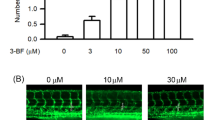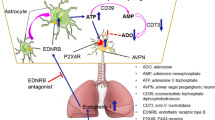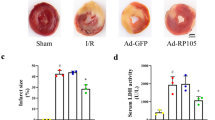Abstract
The dimeric status of nitric oxide (NO)-sensitive soluble guanylyl cyclase (sGC) is obligatory for its catalyzing activity to synthesis the second messenger cyclic guanosine monophosphate (cGMP), which leads to vasodilatation. The present study was conducted to determine whether or not the dimerization of sGC is modulated by thiol-reducing agents and its influences on relaxation of pulmonary arteries caused by NO. The dimers and monomers of sGC and cGMP-dependent protein kinase (PKG) were analyzed by Western blotting. The intracellular cGMP content was measured by enzyme-linked immunosorbent assay. Relaxations of isolated porcine pulmonary arteries were determined by organ chamber technique. Protein levels of sGC dimers were decreased by thiol reductants dithiothreitol (DTT), reduced l-glutathione, l-cysteine, and tris(2-carboxyethyl)phosphine (TCEP), associated with decreased cGMP elevation, attenuated relaxations to NO. DTT at concentrations that affected sGC dimerization and activity showed no effect on PKG dimerization nor relaxation to 8-Br-cGMP. Hypoxia decreased the dimerization and activity of sGC of the arteries. The suppression of DTT and TCEP on sGC dimerization and activity was augmented by hypoxia. In the presence of DTT and TCEP, relaxations of porcine pulmonary artery caused by NO were significantly less under hypoxia compared with those under normoxia. These results suggest that the dimerization and activity of sGC along with NO-induced vasodilatation can be modulated in a thiol-dependent manner. Such a mechanism may be involved in the diminished response of pulmonary arteries to NO under hypoxia.







Similar content being viewed by others
References
Braughler JM (1983) Soluble guanylate cyclase activation by nitric oxide and its reversal: involvement of sulfhydryl group oxidation and reduction. Biochem Pharmacol 32:811–818
Burgoyne JR, Madhani M, Cuello F, Charles RL, Brennan JP, Schröder E, Browning DD, Eaton P (2007) Cysteine redox sensor in PKGIα enables oxidant-induced activation. Science 317:1393–1397
Cleland WW (1964) Dithiothreitol, a new protective reagent for SH groups. Biochemistry 3:480–482
Dangel O, Mergia E, Karlisch K, Groneberg D, Koesling D, Friebe A (2010) Nitric oxide-sensitive guanylyl cyclase is the only nitric oxide receptor mediating platelet inhibition. J Thromb Haemost 8:1343–1352
Dou D, Zheng X, Liu J, Xu X, YeL GY (2012) Hydrogen peroxide enhances vasodilatation by increasing dimerization of cGMP-dependent protein kinase type Iα. Circ J 76:1792–1798
Fernhoff NB, Derbyshire ER, Marletta MA (2009) A nitric oxide/cysteine interaction mediates the activation of soluble guanylate cyclase. Proc Natl Acad Sci USA 106:21602–21607
Friebe A, Koesling D (2009) The function of NO-sensitive guanylyl cyclase: what we can learn from genetic mouse models. Nitric Oxide 21:149–156
Friebe A, Mergia E, Dangel O, Lange A, Koesling D (2007) Fatal gastrointestinal obstruction and hypertension in mice lacking nitric oxide-sensitive guanylyl cyclase. Proc Natl Acad Sci USA 104:7699–7704
Fuchs B, Sommer N, Dietrich A, Schermuly RT, Ghofrani HA, Grimminger F, Seeger W, Gudermann T, Weissmann N (2010) Redox signaling and reactive oxygen species in hypoxic pulmonary vasoconstriction. Respir Physiol Neurobiol 174:282–291
Gao Y (2010) The multiple actions of NO. Pflügers Archiv - Eur J Physiol 459:829–839
Gao Y, Dhanakoti S, Trevino EM, Wang X, Sander FC, Portuga AD, Raj JU (2004) Role of cGMP-dependent protein kinase in development of tolerance to nitric oxide in pulmonary veins of newborn lambs. Am J Physiol Lung Cell Mol Physiol 286:L786–L792
Gao Y, Raj JU (2010) Regulation of the pulmonary circulation in the fetus and newborn. Physiol Rev 90:1291–1335
Garthwaite J (2010) New insight into the functioning of nitric oxide-receptive guanylyl cyclase: physiological and pharmacological implications. Mol Cell Biochem 334:221–232
Garthwaite J, Southam E, Boulton CL, Nielsen EB, Schmidt K, Mayer B (1995) Potent and selective inhibition of nitric oxide-sensitive guanylyl cyclase by 1H-[1,2,4]oxadiazolo[4,3-a]quinoxalin-1-one. Mol Pharmacol 48:184–188
Ghofrani HA, Grimminger F (2009) Soluble guanylate cyclase stimulation: an emerging option in pulmonary hypertension therapy. Eur Respir Rev 18:35–41
Gupte SA, Kaminski PM, Floyd B, Agarwal R, Ali N, Ahmad M, Edwards J, Wolin MS (2005) Cytosolic NADPH may regulate differences in basal Nox oxidase-derived superoxide generation in bovine coronary and pulmonary arteries. Am J Physiol Heart Circ Physiol 288:H13–H21
Gupte RS, Rawat DK, Chettimada S, Cioffi DL, Wolin MS, Gerthoffer WT, McMurtry IF, Gupte SA (2010) Activation of glucose-6-phosphate dehydrogenase promotes acute hypoxic pulmonary artery contraction. J Biol Chem 285:19561–19571
Gupte SA, Wolin MS (2006) Hypoxia promotes relaxation of bovine coronary arteries through lowering cytosolic NADPH. Am J Physiol Heart Circ Physiol 290:H2228–H2238
Han JC, Han GY (1994) A procedure for quantitative determination of tris(2-carboxyethyl)-phosphine, an odorless reducing agent more stable and effective than dithiothreitol. Anal Biochem 220:5–10
Harteneck C, Koesling D, Söling A, Schultz G, Böhme E (1990) Expression of soluble guanylyl cyclase. Catalytic activity requires two enzyme subunits. FEBS Lett 272:221–223
Hool LC, Corry B (2007) Redox control of calcium channels: from mechanisms to therapeutic opportunities. Antioxid Redox Signal 9:409–435
Jung O, Marklund SL, Geiger H, Pedrazzini T, Busse R, Brandes RP (2003) Extracellular superoxide dismutase is a major determinant of nitric oxide bioavailability: in vivo and ex vivo evidence from ecSOD-deficient mice. Circ Res 93:622–629
Keefer LK, Nims RW, Davies KM (1996) “NONOates” (1-substituted diazen-1-ium-1,2-diolates) as nitric oxide donors: convenient nitric oxide dosage forms. Methods Enzymol 268:281–293
Koeppen M, Feil R, Siegl D, Feil S, Hofmann F, Pohl U, de Wit C (2004) cGMP-dependent protein kinase mediates NO- but not acetylcholine-induced dilations in resistance vessels in vivo. Hypertension 44:952–955
Ma H, He Q, Dou D, Zheng X, Ying L, Wu Y, Raj JU, Gao Y (2011) Increased degradation of MYPT1 contributes to the development of tolerance to nitric oxide in porcine pulmonary artery. Am J Physiol Lung Cell Mol Physiol 299:L117–L123
Ma X, Sayed N, Baskaran P, Beuve A, van den Akker F (2008) PAS-mediated dimerization of soluble guanylyl cyclase revealed by signal transduction histidine kinase domain crystal structure. J Biol Chem 283:1167–1178
Mergia E, Friebe A, Dangel O, Russwurm M, Koesling D (2006) Spare guanylyl cyclase NO receptors ensure high NO sensitivity in the vascular system. J Clin Invest 116:1731–1737
Nagahara N (2011) Intermolecular disulfide bond to modulate protein function as a redox-sensing switch. Amino Acids 41:59–72
Neo BH, Kandhi S, Wolin MS (2011) Roles for redox mechanisms controlling protein kinase G in pulmonary and coronary artery responses to hypoxia. Am J Physiol Heart Circ Physiol 301:H2295–H2304
Nowicki PT, Flavahan S, Hassanain H, Mitra S, Holland S, Goldschmidt-Clermont PJ, Flavahan NA (2001) Redox signaling of the arteriolar myogenic response. Circ Res 89:114–116
Qi H, Zheng X, Qin X, Dou D, Xu H, Raj JU, Gao Y (2007) PKG regulates the basal tension and plays a major role in nitrovasodilator-induced relaxation of porcine coronary veins. Br J Pharmacol 152:1060–1069
Qin X, Zheng X, Qi H, Dou D, Raj JU, Gao Y (2007) cGMP-dependent protein kinase in regulation of basal tone and in nitroglycerin and nitric oxide induced relaxation in porcine coronary artery. Pflügers Archiv - Eur J Physiol 454:913–923
Rothkegel C, Schmidt PM, Atkins DJ, Hoffmann LS, Schmidt HH, Schröder H, Stasch JP (2007) Dimerization region of soluble guanylate cyclase characterized by bimolecular fluorescence complementation in vivo. Mol Pharmacol 72:1181–1190
Sylvester JT, Shimoda LA, Aaronson PI, Ward JP (2012) Hypoxic pulmonary vasoconstriction. Physiol Rev 92:367–520
Vanhoutte PM (1989) Endothelium and control of vascular function. State of the Art lecture. Hypertension 13:658–667
Wagner C, Russwurm M, Jager R, Friebe A, Koesling D (2005) Dimerization of nitric oxide-sensitive guanylyl cyclase requires the α1 N terminus. J Biol Chem 280:17687–17693
Wang YX, Zheng YM (2010) Role of ROS signaling in differential hypoxic Ca2+ and contractile responses in pulmonary and systemic vascular smooth muscle cells. Respir Physiol Neurobiol 174:192–200
Waypa GB, Marks JD, Guzy R, Mungai PT, Schriewer J, Dokic D, Schumacker PT (2010) Hypoxia triggers subcellular compartmental redox signaling in vascular smooth muscle cells. Circ Res 106:526–535
Waypa GB, Schumacker PT (2010) Hypoxia-induced changes in pulmonary and systemic vascular resistance: where is the O2 sensor? Respir Physiol Neurobiol 174:201–211
Winterbourn CC, Hampton MB (2008) Thiol chemistry and specificity in redox signaling. Free Radic Biol Med 45:549–561
Wolin MS, Gupte SA, Neo BH, Gao Q, Ahmad M (2010) Oxidant-redox regulation of pulmonary vascular responses to hypoxia and nitric oxide-cGMP signaling. Cardiol Rev 18:89–93
Ying L, Xu X, Liu J, Dou D, Yu X, Ye L, He Q, Gao Y (2012) Heterogeneity in relaxation of different sized porcine coronary arteries to nitrovasodilators: role of PKG and MYPT1. Pflügers Archiv - Eur J Physiol 463:257–268
Zheng X, Ying L, Liu J, Dou D, He Q, Leung SWS, Man RYK, Vanhoutte PM, Gao Y (2011) Role of sulfhydryl-dependent dimerization of soluble guanylyl cyclase in relaxation of porcine coronary artery to nitric oxide. Cardiovasc Res 90:565–572
Acknowledgments
This work was supported in part by the National Natural Science Foundation of China grants 81270341 and 81001433 and the National Heart, Lung, and Blood Institute USA grants HL059435 and HL075187.
Conflict of interest
The authors state no conflict of interest.
Author information
Authors and Affiliations
Corresponding author
Rights and permissions
About this article
Cite this article
Ye, L., Liu, J., Liu, H. et al. Sulfhydryl-dependent dimerization of soluble guanylyl cyclase modulates the relaxation of porcine pulmonary arteries to nitric oxide. Pflugers Arch - Eur J Physiol 465, 333–341 (2013). https://doi.org/10.1007/s00424-012-1176-x
Received:
Revised:
Accepted:
Published:
Issue Date:
DOI: https://doi.org/10.1007/s00424-012-1176-x




